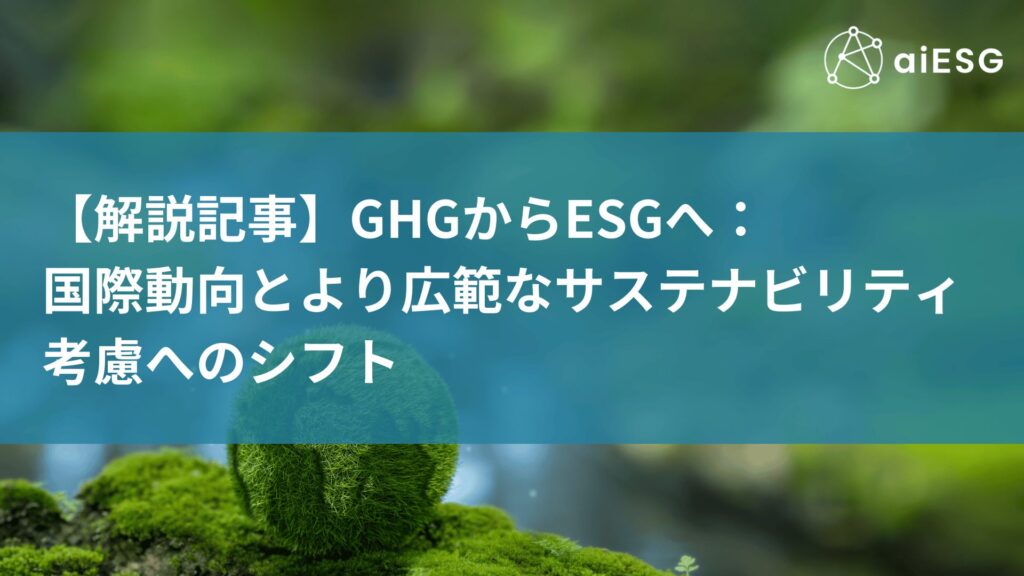INDEX
(Summary)
The European Sustainability Reporting Standards (ESRS) aim to improve the quality and comprehensiveness of corporate sustainability reporting and promote sustainable development through transparency.
The ESRS is an integral part of the delegated rules of the CSRD (Corporate Sustainability Reporting Directive). This means that if a company is subject to the CSRD, it will be required to adopt the reporting standards set forth in the ESRS.
A revised version of the ESRS was published in June 2023 and adopted by the European Parliament and the European Council in October 2023. The ESRS published at this time consists of 12 standards that are defined as cross-industry standards. There are two "Cross-Cutting Criteria" and ten "Topic Criteria". These serve as standards to which all companies subject to the CSRD must commonly conform.
Looking ahead, "sector (industry) specific standards" and "standards for SMEs" will be enacted as components of the ESRS.
The purpose of this paper is to provide a brief description of the ESRS crosscutting criteria that are known at this time.
Please refer to our previous article on CSRD for a more in-depth understanding of the role of the ESRS and the status of sustainability reporting in the EU.
CSRD: The EU version of the sustainability reporting standard just before it comes into effect
~Impact on Japanese companies
https://aiesg.co.jp/topics/report/2301120_csrd/
Table of Contents
(Summary)
1. purpose of the ESRS
2. current published ESRS
Image 1: Schematic diagram of the ESRS as currently published
ESRS1: General Requirements
ESRS2: General Disclosure
Table 1: Items covered by ESRS topics (prepared by the authors from ESRS drafts)
ESRS E1~E5: Environmental aspects
ESRS S1~S4: Social aspects
ESRS G1: Governance
Summary and Future Prospects
Purpose of ESRS
A major objective of the ESRS is the continuous improvement of corporate sustainability performance and management through enhanced sustainability reporting.
The ESRS imposes on companies the obligation to report not only on their supply chain and product life cycle impacts, but also on their consumer, environmental, and social impacts, among others, through key requirements.
The EU has introduced the concept of "double materiality" in both CSRD/ESRS standards as a sense of purpose for the disclosure of non-financial information. The EU intends to have companies clearly state how their economic activities affect the environment (E), society (S), and governance (G).
Due to the nature of the ESRS, which is applied in conjunction with the CSRD, companies applying the CSRD do not need to prepare a separate report for the ESRS.
Currently published ESRS
The ESRS is the currently published revised version (https://www.efrag.org/lab6?AspxAutoDetectCookieSupport=1 The "cross-cutting" criteria are defined in the ESRS (see Section 3.2.2). The term "cross-cutting" here means "imposed on all companies applying the CSRD, regardless of sector" and can be seen as a prerequisite for the ESRS, which sets out more specifically the principles of the CSRD and the rules to be followed in reporting.
As Figure 1 shows, the currently adopted cross-cutting standards consist of two standards, "ESRS1: General Requirements" and "ESRS2: General Disclosures," and ten topic standards.
Figure 1: Overview of the current publicly available ESRS (Japanese translation by the author, adapted from a presentation by the EFRAG agency) https://youtu.be/a1pdAO62bH0?si=8ll6e5PhxkR03mF3 )
ESRS1: General Requirements
It establishes principles for the preparation and disclosure of sustainability reports in applying the CSRD (not including specific report content). It obliges companies to conduct assessments based on the principle of double materiality. Requires materiality assessments to be made in individual standards, with the exception of ESRS2, which is discussed below.
ESRS2: General Disclosure
It sets out the general characteristics, including policies and objectives, that should be reported regardless of the outcome of the materiality assessment. It also details the structure and content of the ESRS topic criteria, including "Governance," "Strategy," "Management of Impacts, Risks, and Opportunities," and "Evaluation Criteria and Objectives." These four pillars are in line with existing international sustainability standards frameworks such as the TCFD and the ISSB Framework.
Table 1 summarizes the items that are specified as annexes to each of the topic criteria. Each is divided into three categories: environmental, social, and governance.
Table 1: Items covered by ESRS topics (prepared by the authors from ESRS drafts)
| [Draft]ESRS Topic | Sustainability Issues Covered by ESRS Topics | ||
| subject | supplementary item | supplementary information | |
| ESRS E1 | climate change | Climate Change Adaptation, Climate Change Mitigation, Energy | |
| ESRS E2 | pollution | Air pollution, water pollution, soil contamination, biological and food resource contamination, substances of concern, and substances of very high concern | |
| ESRS E3 | Water and Marine Resources | Water withdrawal, water consumption, water use, water discharge in water bodies and oceans, habitat degradation and the intensity of pressure on marine resources | |
| ESRS E4 | Biodiversity and Ecosystems | Direct factors affecting biodiversity loss | ∙ Climate change, land use change, direct exploitation, invasive alien species, pollution, other |
| Effect on species status | Examples: ・Species population numbers, global extinction risk of species | ||
| Impact on the extent and condition of the ecosystem | Examples: - Land degradation, desertification, soil cover | ||
| Impacts and dependence on ecosystem services | |||
| ESRS E5 | circular economy | Resource inflows, including resource use; resource outflows and waste associated with products and services | |
| ESRS S1 | corporate Japan's workforce | Working Conditions | The following are some of the issues that should be addressed: - Stable employment, working hours, adequate wages, social dialogue, freedom of association, existence of employee representative committees, workers' rights to information, consultation and participation, collective bargaining (including the percentage of workers covered by collective agreements), work-life balance, and health and safety. |
| Equal treatment and opportunities for all | Gender equality and equal pay for work of equal value; training and skills development; employment and inclusion of persons with disabilities; workplace violence and harassment prevention; diversity | ||
| Other job-related rights | Child labor, forced labor, housing, and privacy | ||
| ESRS S2 | Workers in the value chain | Working Conditions | The following are some of the most important issues that are addressed: - Stable employment, working hours, fair wages, freedom of association including social dialogue and the existence of works councils, collective bargaining, work-life balance, and health and safety. |
| Equal treatment and opportunities for all | The Company is committed to providing a comprehensive, gender-equal and equal pay for work of equal value; training and skills development; employment and inclusion of persons with disabilities; workplace violence and harassment prevention; and diversity. | ||
| Other job-related rights | Child labor, forced labor, housing, water and sanitation, privacy | ||
| ESRS S3 | Affected communities | Economic, social and cultural rights of local communities | ・Housing and food adequacy, water and sanitation, land-related impacts, and security-related impacts. |
| Civil and political rights of the community | Impact on freedom of expression, freedom of association, and human rights activists | ||
| Specific rights for aboriginal communities | ∙ Free, prior and informed consent, self-determination and cultural rights | ||
| ESRS S4 | Consumers and end users | Information-related impacts on consumers and end-users | Privacy, freedom of expression, and access to sufficient information |
| Personal safety of consumers and end users | Health and Safety, Personal Safety, Child Protection | ||
| Social inclusion of consumers and end-users | Responsibility for elimination of discrimination, ensuring access to goods and services, and marketing activities | ||
| ESRS G1 | business activities | Management of supplier relationships, including corporate culture, whistleblower protection, animal welfare, political involvement and lobbying, and payment practices | |
| Corruption and Bribery | Prevention and detection/accident including training |
ESRS E1~E5: Environmental aspects
The five environmental standards include reporting on climate change, pollution, water and marine resources, biodiversity and ecosystems, and resource use and the circular economy. Companies are also required to disclose their approach to transitioning to sustainable business models and their corresponding plans. In addition, it imposes the need to report on the company's efforts to support the environmental goals of the EU Green Deal.
ESRS S1~S4: Social aspects
The four social standards require companies to systematically disclose data not only on their internal employees, but also on their external stakeholders. One of the standards focuses specifically on employees within the value chain. In addition, details about communities and consumers/end-users who are considered to be affected by a company's operations are also addressed in individual criteria. Note that in S2~S4, we focus only on qualitative information.
ESRS G1: Governance aspects
The Governance Standards detail the responsibilities of governance through a better understanding of the entity's approach, operations, and results. It also outlines reporting requirements for managing impacts, risks, and opportunities. In addition, it requires disclosure of the company's fundamental policies and corporate culture, and includes anti-corruption policies, supplier relationships, plus political involvement in the disclosure requirements.
Summary and Future Prospects
The ESRS aims to enhance the quality and comprehensiveness of corporate sustainability reporting and promote sustainable development through transparency. companies applying the CSRD are required to adopt the reporting standards established by the ESRS.
Moving forward, the Commission and the European Council will be discussing and creating sector-specific standards and standards for SMEs. The sectors for the sector-specific criteria currently known are as follows
Oil and Gas
Coal, quarry and mining
Road Transportation
Agriculture, Dairy Farming and Fishing
Automobile
Energy Production and Utilities
Food and Beverage
Apparel and Jewelry
To begin with, after discussing the provisions for the oil and gas sector, the overall application of the sector-specific standards is scheduled to begin in 2026.
As the CSRD will start to apply to SMEs in 2026, it is expected that the standards for SMEs will be addressed before then. The CSRD will begin to apply to SMEs in 2026.
aiESG provides support for everything from basic CSRD to actual disclosure of non-financial information, so if your company is having trouble with CSRD, please contact us.
Contact us:
https://aiesg.co.jp/contact/
Related page
CSRD: The EU version of the sustainability reporting standard just before it comes into effect
~Impact on Japanese companies
https://aiesg.co.jp/topics/report/2301120_csrd/
What is the SASB Standard for ESG Information Disclosure? (Part 1)Outline of SASB
https://aiesg.co.jp/topics/report/2301025_sasb1/
Explanation] What is TNFD? A new bridge between finance and the natural environment
https://aiesg.co.jp/topics/report/230913_tnfdreport/















